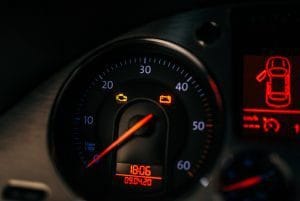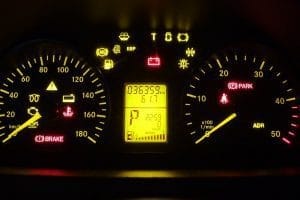Anti-lock braking system (ABS) is a braking mechanism, which prevents the wheel from locking up under emergency braking situations. If wheels get locked our vehicle will skid which may result in a number of consequences such as an increase in braking distance or loss of steering control.

Working of Anti-Lock Braking System (ABS)
The braking force applied by the driver in an emergency braking situation can be more than the capability of a normal brake to handle which in result can lock the wheel and cause the wheel to skid with uncontrollable steering and unstable handling.
It works on the principle of pressure holding, pressure reduction, and pressure increase.
So in order to handle such scenarios anti braking system is introduced, ABS is equipped with wheel speed sensors that measure the speed of the rotation of the wheel and pass the information to ECU or ABS control unit which in turn operates hydraulic modulator that controls the pressure of brake fluid lines which maintains the pressure on brake pads of disc.
In ABS system instead of applying sudden braking, a stop and release braking is applied on the wheel.
Though the driver has applied full pressure on the brake pedal but still in ABS integrated vehicles the wheel will not lock instead of getting lock it will apply a sudden braking and then a small release of brake and then again it will apply the brake (also known as modulation of brake pressure at each wheel), this will continue until the vehicle stops or gets back into a stable condition.
Comparison between Conventional braking (Left side) and Anti Braking System (Right side)

Components and Sub-components of Anti-lock braking system (ABS)
1- Wheel speed sensors
Wheel speed sensors are simple inductive sensors or Hall speed sensors which work with the conjunction of the toothed wheel, as the toothed wheel rotates it causes the change in the inductance of the magnetic circuit and generates a signal, voltage and frequency which are directly proportional to wheel speed.
These frequency signals are used by ECU to control hydraulic modulators.
2- Electronic control unit
The function of the electric control unit is to collect the information from the wheel sensors and calculate the best suitable action for the hydraulic modulator.
3- Hydraulic modulator
The function of a hydraulic modulator is to –
- To open the pressure build-up brake line from the pump.
- To hold and close pressure buildup brake line.
- To open the pressure release brake line to the reservoir.
Note-
The hydraulic modulator of the ABS system is integrated with the valves controlled by electrical solenoids having very low inductance which makes them very fast to react.

Anti-lock Braking System fault diagnosis
Problem- ABS warning light is on or ABS not working
Causes-
- The air gap between the wheel sensor is incorrect.
- High resistance or open circuit in modulator windings.
- Earthing or power supply is not available to ECU.
- Loose Wire connection.
- Contamination of wheel sensor in air gap.
What is Servo Assisted Braking
Servo assisted braking uses a vacuum servo to provide assistance to the driver by decreasing the braking effort acquired, it is commonly known as brake booster in the US.
In Servo assisted braking the vacuum booster is attached between the master cylinder and the brake pedal which assist the braking force applied by the driver.
For the operation of Servo assisted braking, a system uses a low-pressure vacuum from the manifold on one side and the higher atmospheric pressure on the other side of the diaphragm.
The pressure difference causes a force, which is used to operate the master cylinder, this force is in addition to the driver’s foot force that pushes on the master cylinder piston.
As soon as the driver removes his foot from the brake pedal the air from the supply chamber escapes.





